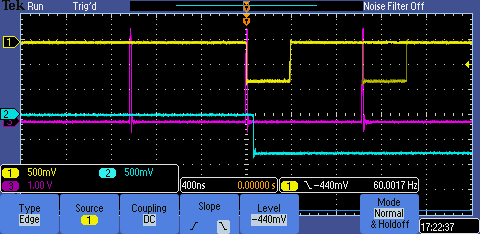|
HOME
ESR
EXPERIMENTS
LABS etc
|
|
E121
E127
E132
E125
E143
laser_cooling_2021
E142
Ê128
E146
E0052
E0018
E0028
E0038
E0075
E0203_E0018
E0052_2025
E0281 - NEEC
|
| Nuclear hyperfine mixing in 229Th89+ |
Not logged in |
 |
|
|
|
Message ID: 102
Entry time: Tue Apr 5 20:58:53 2022
|
| Author: |
Wilfried |
| Category: |
Laser |
| Subject: |
Trigger for Laser |
|
|
Electronic for the timing of the laser puls optimized. The problem with the broad photodiode histograms is solved.
The photo of the oscilloscope picture shows in magenta the pulses from the (discriminated RF)/2, in yellow the pulses that are generated to open the Q-Switch. The latter are generated by the coincidence of the 30-Hz trigger (2 microsec long) to
allow for the Q-Switch to be fired. Within this period are usually 2 pulses from the RF and both generate a 100 ns long coincidence puls. The first one of those creates a 50 microsec long window (light blue) that is send to the Q-switch. The length
and the delay of this pulse can be changed. While the length is kept fixed, the delay can be changed in order to shift the arrival time of the laser pulse at the electron cooler to coincide with the ion bunch.
The problem of the wide photodiode histograms and the background was caused by a too large pulsewidth of the discriminated RF. The magenta pulses were about 100 ns long. Any pulse that arrives within a timespan between 99 and 0 ns before the 30-Hz
trigger of the Q-switch "allowance" will trigger a laser pulse immediately at the start of this trigger and therefore a jitter of up to 100 ns can occur. Therefore it is important that the CFD pulses are as short as possible, we set them to 20 ns
and the width of the photodiode histogram was just 3 bins wide (at the foot maybe 5 bins).
I (Rodolfo) just added the picture with the cabling configuration. The colors of cables match together with the colors show in the oscilloscope. |
|

|
|